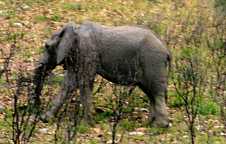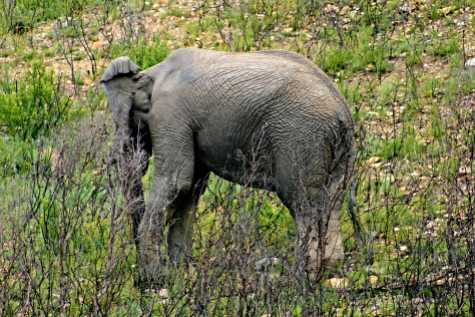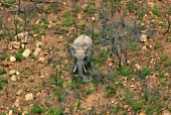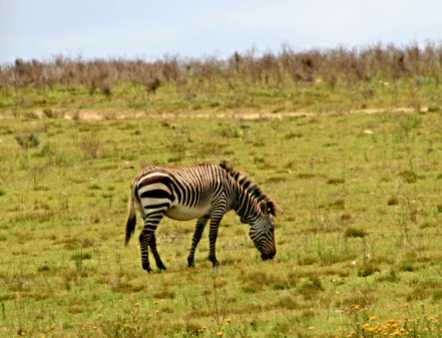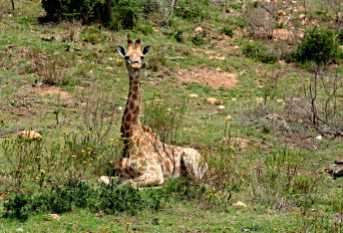While we were in Mossel Bay, South Africa, back in December, we decided to take a trip about 30 minutes from town and visit a game preserve called, Botlierskop. Say that 5 times fast. Honestly, I can’t remember the name to save my life and had to look it up again before I started this blog. I wasn’t expecting much, for some reason. I’d already been to several preserves in South Africa and I just assumed that the preserves further north were better. Boy was I in for a big surprise.
We got there and waited for our day tour to begin. It was a nice facility and seemed quite organized. Outside there were about 10 large, raised vehicles with 6 benches in the back, and the windows and sides were open. We had been to other facilities where the back was caged in, but I much prefer the open ones. Of course, I suppose that depends on what you’re going to see. The ones we saw that were caged in were visiting several large groups of lions and feeding them, so that definitely makes more sense.
The picture clusters I’m going to share with you are going to be shared as we saw them. First we saw zebras and a pretty decent herd of wildebeests. We learned a few things about them. First off, many of the animals of Africa have a collection of veins somewhere on their bodies. On zebras and wildebeests, there is a collection of skin and veins under their throats. These are basically a way for the animals to cool themselves down. If they didn’t have these, they would overheat. Elephants have the collection of veins on their ears. I found that quite interesting. Also, note that most of the female wildebeests were pregnant as they try to have a big batch of babies at the same time to increase survival of the herd.
We left the wildebeest area and to the right we saw this. Oh look, what a cute little deer thing. Don’t ask me what this is called, I’m sure someone reading this knows.

While we were all looking at this someone said, oh wait, look to the left and this opens up to our view. Dah-dah-dah! Rhinos! A magnificient little family sitting in the shade.
From there we moved on and saw some deer-like animals and some nice scenery, including a view of the ocean from the preserve. Also a recent fire had come through the area and I was fascinated by the reaction of the plants and how they survived and dropped their seeds despite the fire.
Next up, we got to see some elephants. Notice the one shot where I captured the veins on the back of the elephant’s ears. These elephants, as most elephants I have encountered, were majestic and also dangerous. We were very wary as we drove through them as they sometimes charge and are often tempermental and unpredictable. Many of these shots are distance shots.
Next up, the lions. Honestly, the other preserves I’ve been to have a much better group of lions. To me, this is the only part of this preserve that didn’t exceed my expectations. But they were doing what most lions do. Laying around. Waiting for their next meal. At one of the preserves we visited, they said that lions are actually bigger scavengers than hyenas. If they don’t have to hunt and kill their prey, they won’t. They’re quite lazy. But they are still nice to look at. This lion was quite young with his little harem of two females. There are actually groups of lions that hunt with each other, meaning multiple prides hunting to gether, to bring down elephants, for example. They call these super-prides, I believe.
Next up the springboks! We saw a nice collection of these in the park. They were quite beautiful with their multicolored faces and rear-ends. The pictures at the bottom, where they’re standing in the middle of the road, they appeared to be praying with their heads down and their heads were also bobbing a little, as if they were in meditation.
After we passed through this group of springboks, we came across a group of animals all bunched together. Giraffes, rhinos, and zebras. What a combination as we sat in the back of our truck and just took them all in. So lovely to see.
We also saw a few more giraffes later in the trip. You can tell the difference between male and female giraffes by looking at their horns. Males tend to use theirs and they don’t have a lot of hair on them. Also, males tend to be darker than the females.
We ran across these two groups of symbiotic animals. Almost every kudu had a cattle egret following it and it was quite interesting to watch. I’d call these needle-nose egrets, if the naming conventions were left up to me. I love the stripes on these deer-like animals.
That was pretty much the end of the tour. We got back to the lodge and had a delicious lunch and a few drinks and just lounged outside on the patio. We assumed the party was over. Boy were we mistaken. Over the next hour we had visits on the lawn from all kinds of animals, who just strolled across like they were taking a walk in the park. It was a great additional opportunity to get photos and watch them enjoying their environment. Wildebeests, and the same group of rhinos we saw earlier came strolling along and the rhinos decided to take a roll in the mud. They were funny to watch. The lodge also offers horseback tours, so we had them come across the lawn at one point. One of the pictures below has rhinos, wildebeests, horses, and a few different species of birds by the pont. The patio was next to the pond and there were lots of birds that liked to hang out including this longer-tailed bird that hardly seemed to be able to fly with the weight of his tail. And of course the weavers were there with their bulbous nests. We were told that the patio had been enlarged, which covered up a bunch of the tall grassy areas on the pond where weavers like to weave their nest. As you can see from the photo below, they are resilient and will build their nests on the patio if they have to.
Overall it was a wonderful safari-filled day. It was only a 3 hour tour, but it was still one of the better preserves I’ve been to and the after-tour party was to die for. As always, don’t forget to follow the adventure on email by subscribing, or you can follow me on Facebook, Tumblr, Twitter, Google+, Instagram.






















